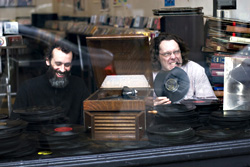“When I listen to old music, that’s one of the few times I actually have a kind of a love for humanity,” sighs legendary cartoonist Robert Crumb, as he sifts through his expansive collection of old records in the documentary Crumb. “You hear the best part of the soul of the common people; you know their way of expressing their connection to eternity. Modern music doesn’t have that kind of calamitous loss that people can’t express themselves that way anymore.”
Crumb is an avid collector of one of the earliest forms of recorded music, 78s (named for the speed, or revolutions per minute, at which they’re intended to be played). And it was one of Crumb’s comics that led Seattle musician and Wall of Sound Records co-owner Jeffery Taylor to a treasured find of his own.
“Jeff was kind of sifting through these stacks I had,” recalls Rob Millis, Taylor’s bandmate, collaborator, and longtime friend. “He pulled one out and said, ‘This is in a Robert Crumb cartoon!’ [In the comic] Crumb tries to get this record from someone. But the guy won’t sell it to him for just $5, and he can’t get it out of his head. The last panel is him buying it at auction 30 years later.”
That same track, “Memphis Kick Up” by Slim Lamar and His Orchestra, a hissy delight peppered with crackles, pops, warm clarinet solos, and bright, dancing brass, recorded in 1929, ended up making the final cut of the painstakingly narrowed-down selections for Millis and Taylor’s recent labor of love, Victrola Favorites: Artifacts From Bygone Days, a book and two-disc compilation of 78s. The joint effort of these two musicians, who’ve been playing together in the experimental/avant band Climax Golden Twins for more than a decade, is a breathtaking aural scrapbook. And while many 78 compilations of this kind already exist (the most noteworthy being the Anthology of American Folk Music), Millis and Taylor’s distinguishes itself by representing rare recordings from different parts of the world, from chanting Chinese Buddhist nuns to call-and-response tunes from the Republic of Congo, as well as several tracks from the good old U.S. of A., from the 1920s through the ’50s.
Though just released, Victrola Favorites was seeded by a project Millis and Taylor had started several years ago. Both serious record collectors since the early 1990s, they began to cultivate an avid interest in 78s at about the same time.
With their combined troves of old records, they curated a series of cassette tape compilations (also titled Victrola Favorites) that ultimately grew to 10 volumes over a three-year period. Distributed via Anomalous, they garnered a modest but loyal following. One fan was Lance Ledbetter, a next-generation Harry Smith (creator of the American Anthology of Folk Music)–style archivist who had launched the Atlanta-based archival record label Dust-to-Digital, which specializes in historical compilations such as the Grammy-nominated five-disc box set Goodbye Babylon, an extensive collection of rare, vintage religious music.
After the cassette comps waned around 2000, Ledbetter was looking to obtain a Climax Golden Twins record via trade for one of his Dust-to-Digital releases, Where Will You Be Christmas Day?, a collection of pre-1960s holiday-themed roots-music recordings. From there, the three collectors established regular correspondence, and during a trip to the West Coast for the Grammys, Ledbetter headed to Seattle to meet Millis and Taylor in person. What happens when three avant-garde/old-timey music-loving minds meld? Far-out ideas are born, and they all agreed to revitalize the Victrola Favorites compilations through Ledbetter’s label.
“The cassettes were totally about the songs. The cassettes were actually just about the sound on the old Victrolas; they had no information on them,” says Millis. “So we wanted to go in the opposite direction with the book.” Somewhat in the spirit of Smith’s original Anthology of American Folk Music, Millis, Taylor, and Ledbetter’s Victrola Favorites: Artifacts From Bygone Days is a largely artistic, rather than academic, venture.
Visually, Victrola Favorites is stunning—a nearly text-free book featuring photos and advertisements that whisper from the past. Inside the front cover, behind Disc 1, artfully rendered beetle-like bugs appear to be crawling, as if you’d just lifted a moldy box of 78s in a basement. Beneath Disc 2, on the back cover, careful readers can discover that “Lac (lak) n.” is “a resinous substance secreted by scale insects found primarily in India and Southeast Asia. These insects swarm on trees and leave a thick coating of this resin. Purified lac resin was used in the making of shellac records.”
Artwork from Taylor’s and Millis’ respective collections is represented throughout (some of it is from the records found on the CDs, but most has no correlation) and is presented without any definable order, other than aesthetic. The jacket for one record touts a product claiming to eradicate pests (rats, mice, even squirrels!), which then gives way to a close-up of a record from the Orient. Beautiful antique illustrations and old photographs of people actively listening to the then-newfangled Victrola machines are woven throughout, recalling a time when the musical listening experience was an interactive event, not just a headphone afterthought that acts as an isolating barrier between us and the outside world.
Much like the Climax Golden Twins’ 2004 release, Highly Bred and Sweetly Tempered, which features a mysterious sampling of old records patched together with their experimental style, the music and artwork on Favorites is a collage of things that freely span time, space, and culture, with no categorical constraints. Noble Sissle and His Orchestra’s “The Basement Blues” (described in the book as “Low-downer than any low-down blues”) gives way to Blind Boy Fuller’s bouncy blues-rock number “Step It Up and Go,” and so on. But more important, a striking and bare African chant opens Disc 1, followed by a wavery and delicate Cantonese opera troupe, then a 1950s Greek track, then one from 1930s Portugal and an instrumental from India. American 78s have been archived ad nauseam, but Victrola Favorites is proof that a wealth of vintage foreign recordings is still waiting to be unearthed.
“Charlie Patton gets all this hype—I mean, justifiably so, he’s amazing,” Millis says. “But I think there are Japanese artists who are just as amazing, who are just as important and unique as Charlie Patton or Robert Johnson,” Millis muses. “But no one really knows yet that those people exist.”






